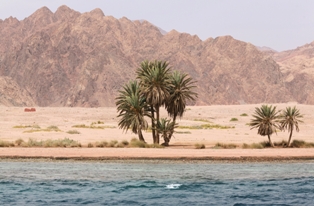An excerpt from the Safar-nama of Nasir Khusraw
“Going East from Egypt, you reach the Red sea. The city of Qulzum is located on the shore of this sea, thirty leagues from Cairo. This sea is a gulf of the ocean that splits off at Aden to the North and at Qulzum. The width of this gulf is said to be two hundred leagues. Between Cairo and the gulf is mountain and desert where there is neither water nor growth. Whoever wants to go to Mecca from Egypt must go East. From Qulzum there are two ways, one by land and one by sea. The land route can be traversed in fifteen days, but it is all desert and three hundred leagues long. Most of the caravans from Egypt take that way. By sea it takes twenty days to reach Al-Jar (a small town in Hejaz on the sea). From Al-Jar to Medina it takes three days. From Medina to Mecca is one hundered leagues.
Following the coastline from Al-Jar, you will come to the Yemen and the coast of Aden; continuing Southward from Aden and slightly Westward, you will come to Zanzibar and Ethiopia. Then, through Nubia, you come to the province of the Masmudis, which is a land of broad pasture lands, many animals, and heavy-set, strong-limbed, squat, black-skinned men; there are many soldiers of this sort in Egypt, with hideous faces and huge bodies. The Masmudis fight as infantry with swords and spears, as they are incapable of wielding any other weapons.”
Source: Thackston, W. Wheeler McIntosh, ed. trans., Nasir-i Khusraw’s Book of Travels (Costa Mesa, CA: Mazda Publishers, 2010), 55-56.
In antiquity, the stretch of the Red Sea from Jidda to Qulzum was known as al-Jar. The Romans had favoured the Red Sea for trade with India and China since the time of Emperor Augustus (r. 27 BCE-14 CE) who gained control over the Mediterranean and the northern Red Sea.
Ibn Khurradadhbeh, a 2nd AH / 9th CE century Persian geographer and bureaucrat, wrote that many Jewish merchants from the south of France travelled from the east to the west and back along this coast. They spoke Arabic, Persian, Greek, Frankish and Spanish, and sailed on the eastern Red Sea from Qulzum to al-Jar and Jidda. From there they travelled to Sind, India and China. Goods from China were imported via the Indian ports. The merchants brought to Qulzum musk, aloes, camphor, cinnamon and other products, transported these to Farama or Constantinople, and sailed back.
Citation:
Lewis, Bernard, The Arabs in History (Oxford: Oxford University Press. Sixth Edition, 2002).
Gordon, East, W., The Geography Behind History: How Physical Environment Affects Historical Events (New York: W. W. Norton & Company, 1999).
Hunsberger, Alice C., Nasir Khusraw, the Ruby of Badakhshan (London, I. B. Tauris, 2000).
Hourani, George, Arab Seafaring (Princeton, NJ: Princeton University Press, 1995).
Hunsberger, Alice C., Nasir Khusraw, the Ruby of Badakhshan (London, I. B. Tauris, 2000).
Lopez, S. Robert and Taymond, W. Irving. Medieval Travel in the Mediterranean World: Illustrative Documents (New York: Columbia University Press, 2001).
Trade between the Romans and the Empires of Asia. Metropolitan Museum of Art.
http://www.metmuseum.org/toah/hd/silk/hd_silk.htm [accessed July 2013]
The Silk Road and Arab Sea Routes (Geography of Transport Systems)
http://people.hofstra.edu/geotrans/eng/ch2en/conc2en/silkroad.html [accessed August 2013]

